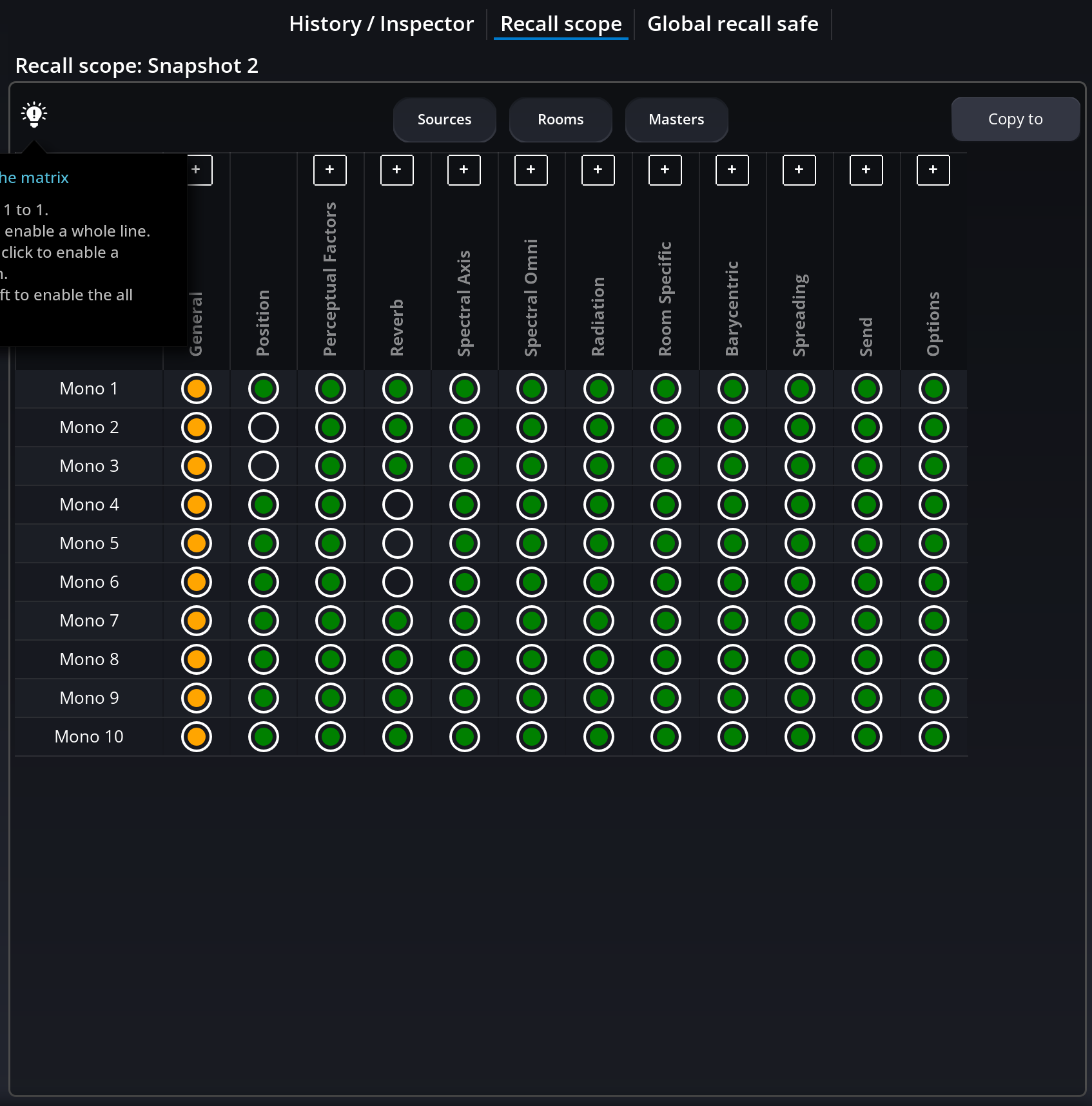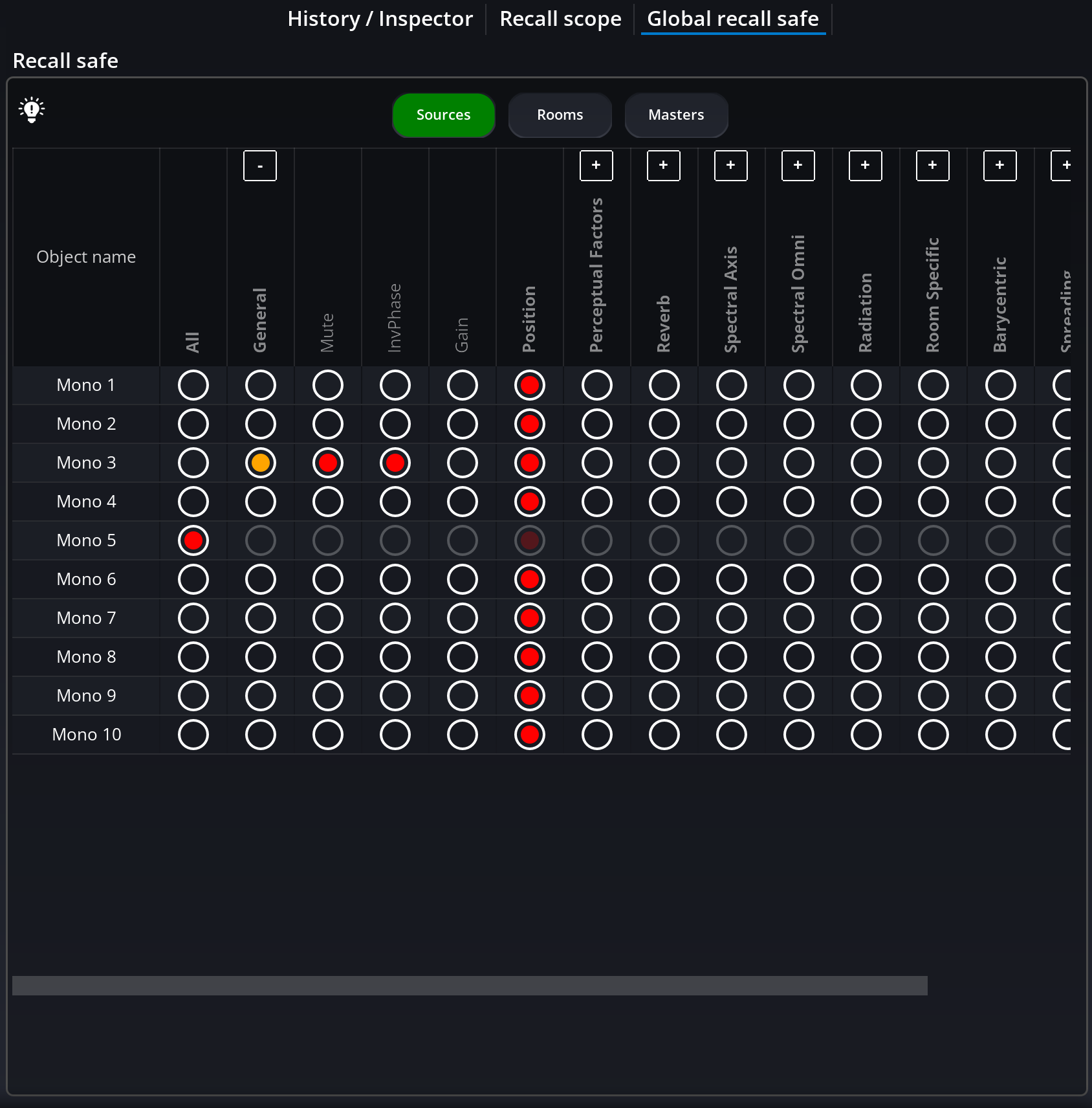Snapshots page
The new Snapshots page of SPAT Revolution allows the user to deeply manage its show. Snapshots are an easy way to create different session states. A classic example would be to have different snapshots for different songs, or sections of a song, in a live show.
The system built in SPAT Revolution is both simple and powerful. As a generality, when a snapshot is created, it stores the mix parameters, i.e. the source, room and master parameters. All parameters are always stored, but it is possible to filter the recalled parameters.
The page is divided into three different sections: the snapshot list, the versions’ history and the inspector.
The snapshot list
Generality
The snapshot list is the main section of snapshot management and serves many purposes. First, it displays the snapshot organization of your session. The snapshot name can also be edited by clicking on the text field. To recall a snapshot from the snapshot list, simply double-click on the number of one of them.
Snapshot selection
A snapshot can have different states. First, it can be selected or unselected inside the list. It will serve to make a specific action on the selected snapshot(s) and reveals the versions’ history and inspector section (if only one is selected). The state of selection is a graphical element that let the user know on which snapshot an action is performed.
 Unselected snapshot
Unselected snapshot
 Selected snapshot
Selected snapshot
Snapshot activation and deactivation
A snapshot can also be disabled using the dedicated toggle. A disabled snapshot will be darkened in the list. It cannot be recalled. The next and previous snapshot buttons on the snapshot toolbar will automatically skip a disabled snapshot.
 Activated snapshot (1) VS. deactivated snapshot (2)
Activated snapshot (1) VS. deactivated snapshot (2)
Current snapshot
Lastly, the last recalled snapshot is displayed with the “current” field set on. This allows the user to monitor where he is in his show.
 In-play snapshot (2) VS. not-in-play snapshot (1)
In-play snapshot (2) VS. not-in-play snapshot (1)
The actions
This snapshot list’s top bar regroups all the snapshot actions:
Newallows creating a new snapshot, storing the current sources, rooms and masters state.Duplicateallows duplicating the current snapshot selected in the snapshot list.Updateallows updating the selected snapshot in the snapshot list with the current state of the session. It will create a new snapshot version.Removeallows deleting the snapshot(s) selected in the snapshot list.Move upmoves the selected snapshot(s) up one row in the snapshot list.Move downmoves the selected snapshot(s) down one row in the snapshot list.Recallallows loading a previously saved snapshot selected in the snapshot list.
Keep in mind that a source with “Snapshot” parameter set off will be stored, but not recalled. Please check the “item page” section for more information.
Snapshot Index
To recall through OSC a snapshot, the name or the index is required. As snapshot order can be changed, the snapshot index does not depend on the snapshot position in the list. The snapshot index is indicated on each snapshot, on the left side of the recall options.
It is possible to generate new indexes for all the snapshots according to list order. To do so, click on the menu Snapshot/Reindex all snapshots.
Last, the index can be manually edited, by right-clicking on a snapshot and selecting Edit snapshot index.
The action Reindex Snapshots, found in the upper Snapshot menu reindex all the snapshots, starting from 1 and by their order in the snapshot list.
Recall options
Recalling a snapshot will use four different options:
- The timing is the transition time between the current session state and the session state recalled from a snapshot. This allows smoothing out the transition between two scenes and can also be used to create some movements.
- The source option defines if the sources state should be recalled. This refers to the sources’ position and other properties.
- The room option defines if the rooms’ state should be recalled. This refers to the reverb parameters of rooms and also the listener’s head. Be careful with this as some parameters of the reverberation can’t be recalled without sound dropping.
- The master option defines if the masters’ state should be recalled. This refers to the master level output.
By default, only sources’ properties are recalled from snapshots. If only some parameters are recalled, the whole session is stored on the creation of a snapshot. For rooms, the setup parameters like distance scaling, protection zone parameters, etc. are deactivated from snapshot recall.
The parameter source, room master options are not editable by themselves, but via the snapshot recall scope matrix. Green means that every parameter of objects will be recalled, while orange means that only some elements will be recalled. Snapshot recall scope is explained below.
Using global options or overriding them
The snapshot list exposes the four global recall options in its top right corner: the recall timing, the sources recall option, the rooms recall option and the masters recall option. These parameters affect each snapshot with global options activated.
Beside each snapshot, there is a checkbox, under a column named “Global options”. If the checkbox is checked, the default values of the recall preferences refer to the global values. If the checkbox is unchecked, it will override the global preferences and use the specific recall values for the snapshot.
Relative recall option
Relative recall is an option of the recall function. It allows recalling a snapshot while preserving anything that was offset from the previous state. This can help to prevent technical problems during a show.
Here is an example: let’s say you have two snapshots, A and B. Sources inside your project have different gains between the two snapshots: 0 dB for snapshot A, -5 dB for snapshot B. Now, let’s presume that once the show is started, you feel that one of the sources is too quiet (the singer preserves his voice). So you grab the gain parameter and trim by 4 dB. The “Relative recall” function will preserve this offset to any of the future recalled snapshots. Recalling snapshot B will set the gain of the singer to -1 dB instead of -5dB. This allows a perfect blend of live mixing and preparation work.
Changing snapshots’ color
To help to a better organization of the session, snapshots can be recolored. To do so, right-click on the selected snapshot and choose Set colors. A palette, from which you can pick a color, will appear.
It is also possible to Generate colors automatically for a multiselection of snapshots. Right-click on one of them and click on the corresponding list entry.
Version history
On this panel takes place a very powerful feature. For each snapshot, SPAT Revolution automatically stores the last versions. By default, ten versions are stored. It is possible to increase or decrease this number on the Snapshot panel of the Preferences page. Of course, you can recall any of these ten previous states, or remove one.
An entry in the version history has for indication its of creation date and time. To describe the version, you can insert a custom note.
The Active field allows choosing which version will be used when the snapshot is recalled. Only one version can be activated.
A set of actions is presented at the top:
- A previous snapshot version can be recalled by clicking on the
Recallbutton. The recalled version will be indicated by the Current field. - Versions can be deleted, by clicking on
Delete. - All versions excluding the selected one(s) can be deleted, clicking on
Delete all other versions.
The action Consolidate Snapshots, found in the upper Snapshot menu remove all the unused snapshot version to lighten the weigth of the session file.
Snapshot recall scope
The snapshot recall scope panel enables to get granularity over which parameter to recall for each object, for the selected snapshot(s). This panel is contextual to the snapshot list selection. If the “Default recall scope” table is focused, it will display the default behavior applied to snapshot with “Default options” enable.
This table represents the different objects and their dedicated properties. Three tabs exist for the three types of objects with snapshot recall: sources, rooms and masters. By default, the table displays a granularity by category. You can access a by-property granularity clicking on the “+” button on the top of the column. If some properties inside the same category do not have the same recall status, the category will appear orange. In case of multiselection, when a value is different between snapshot, it will appear as orange.
You can copy a recall scope matrix to another snapshot using the Copy to button, and selecting the targeted snapshots.
Some shortcuts are available to enable or disable: - a complete line: shit + click - a complete column: Alt/options + click - the complete matrix: ctrl + Alt/options + shift + click
Snapshot recall safe
Snapshot recall safe parameters are used to isolate parameters and objects from the recall of all snapshots. It is global to a session. The snapshot recall safe table has the same behavior as the recall scope one. The only difference is the second column, All, which disable all the parameters object from snapshot recall. This is the equivalent of the Snapshot property available for a source in the Items page, and Room page (while right-clicking on a source in the source list).
Inspector
The inspector lets you visualize the difference between the current state of your session and the selected snapshot, and the selected version of a snapshot.
It allows easy monitoring of what was changed and how it was changed.
Select the snapshot you want to compare, and click on the Show differences, or use the shortcut Ctrl + D on Windows, Command + D on macOS.
You can group the list by an object name or a property name, or research for objects or properties.
Propagate through snapshots
In order to edit a large number of snapshots, a propagation system has been implemented into the new Snapshot Page.
There are two possibilities to propagate values:
- Propagate the differences between the current state and the current snapshot.
This behavior happens by clicking on the Propagate button located on the Snapshot bar, or on the top of the snapshot list of the Snapshot Page.
- Propagate the differences between the current state and the selected snapshot and version. It is deeply linked to the Snapshot inspector. The
Propagate differencesaction is located on it.
It is possible to propagate the selected differences or all the differences (if no differences are selected). To select differences, use Ctrl + Click on Windows, or Cmd + Click on macOS to add several items, or Shift + Click to select all between two items.
Propagate dialog
On the propagate dialog, the selected data will be retrieved, displaying the absolute value which can be applied when validating on Propagate absolute valuesand the trim value which will be added to each snapshot value when validating with Propagate trim values.
For example, if my Accordion has an azimuth value of 50.0, it will become 13.475 propagating with absolute value, and 50.22 propagating with trim value.
On the left panel, the snapshot list is displayed in order to choose the snapshot for which the propagation will be applied.
On the right panel, the differences are displayed. It is possible to select them in order to filter which ones will be propagated. Do not select rows to propagate all the values.








